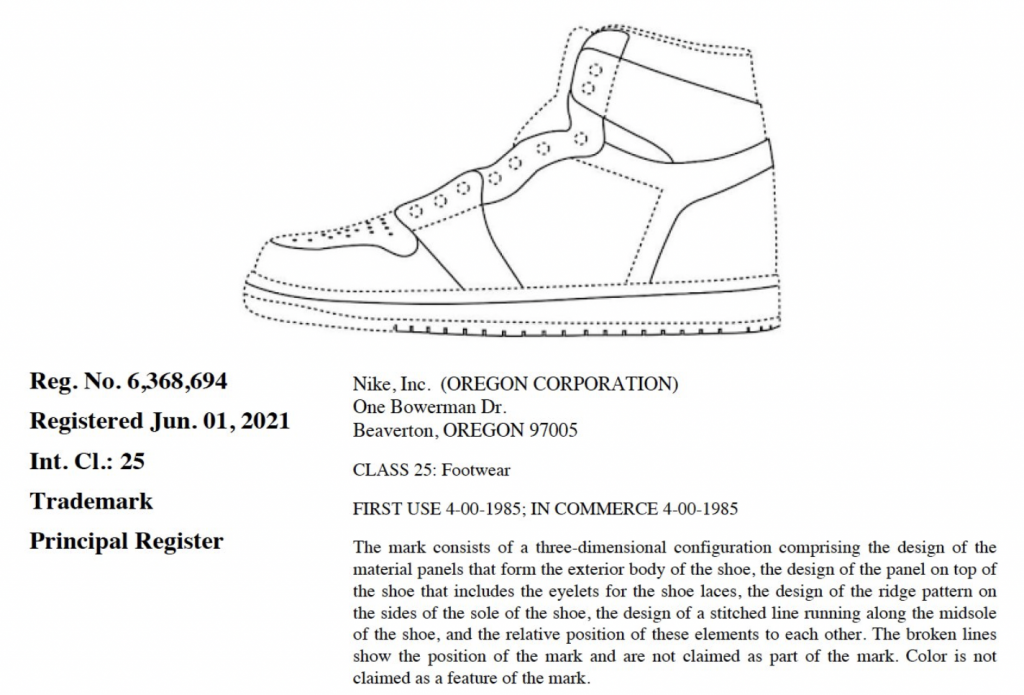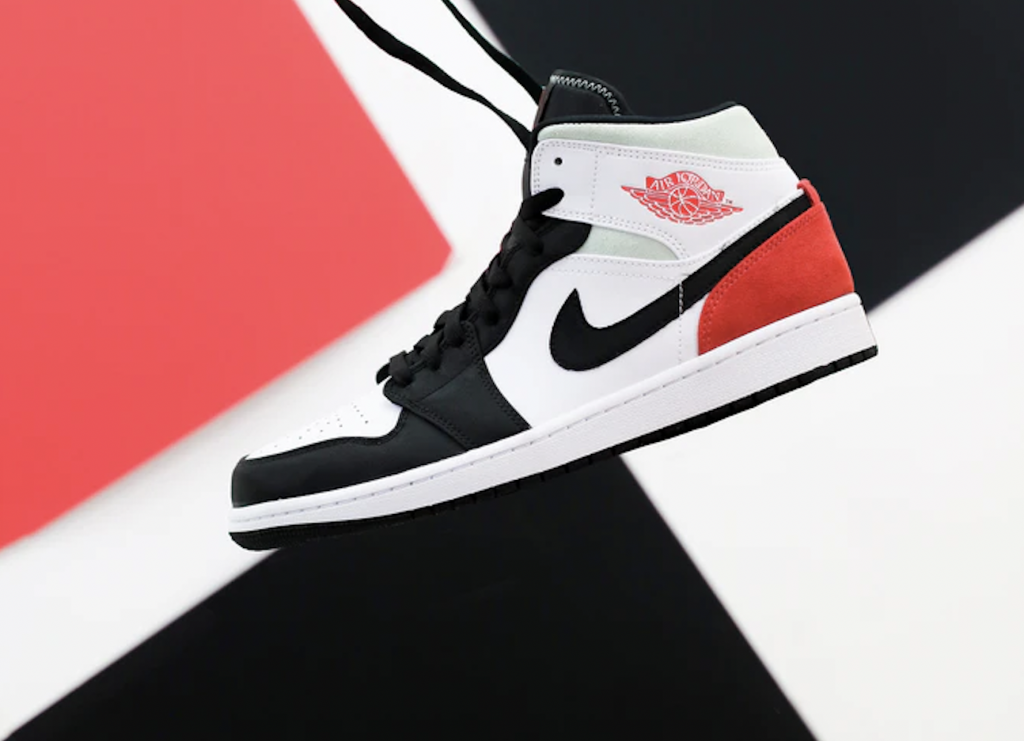Amid decades-long demand for some of its most iconic offerings, Nike has been amassing a number of trademark registrations for everything from the design of its shoe soles to the configurations of the aesthetic elements that make up the body of the shoes, themselves. In the latest trademark registration awards for Nike, the U.S. Patent and Trademark Office (“USPTO”) has granted its bids for registration for the ornamental elements of a number of its Air Jordan 1 sneakers, a nod to the fact that those elements serve the same function as Nike’s brand name and its swoosh logo: they alert consumers about the source of the product.
In a registration issued on June 1, the USPTO gave the green-light to the application that Beaverton, Oregon-based Nike filed in July 2020 for its Air Jordan 1 silhouette, namely, a 3D “configuration comprising the design of the material panels that form the exterior body of the shoe, the design of the panel on top of the shoe that includes the eyelets for the shoe laces, the design of the ridge pattern on the sides of the sole of the shoe, the design of a stitched line running along the midsole of the shoe, and the relative position of these elements to each other.” At the same time, the USPTO also granted two of Nike’s applications for registration for low-top versions of its AJ1 sneakers, both of which were filed for in late July 2020 for use in trademark Class 25 (i.e., on sneakers).
The newly-issued registrations, as first cited by Sneaker Law Firm’s Zakari Kurtz, come as Nike has been looking to supplement its already-existing trademark protections in these footwear designs (that exist as a result of its consistent use of – and marketing of – these marks) with registrations, thereby, enabling the Swoosh to benefit from additional, heightened remedies in the event of unauthorized replication of the sneaker designs. This is particularly relevant given the unending stream of lookalike offerings and counterfeit goods being offered up by companies ranging from Chinese wholesalers to the likes of Warren Lotas and who could forget … Brooklyn, New York-based entity MSCHF and its controversial Jesus and Satan sneakers.
In its quest to bolster its already-expansive trademark portfolio, Nike has been busy filing an array of applications for registration with the USPTO over the past several years, and in the past couple of months, in particular. Since filing applications for registration for the configurations of its Air Jordan 1 styles, counsel for Nike has also lodged applications for registration for the configuration of its Air Max 90, Jordan 3 Retro, Jordan 4 Retro, Jordan 5 Retro, Jordan 11 Retro, and Nike Air Foamposite One styles, as well as an array of brand-specific word marks and logos that it is looking to bolster its protections for.

What might be one of the most interest takeaways from the newly-issued registrations, as well as the currently pending applications for registration, is that just as Nike’s past applications and subsequently-issued registrations claim rights in the majority of the elements of the sneaker designs at issue, they are all devoid of one striking element: the Swoosh that traditionally appears on the side of the sneakers. The move by Nike’s counsel to seek registrations for the sneaker designs sans the swoosh trademark is a noteworthy one, as it enables Nike to claim broader protection than if the swoosh were included. As such, protections for the various silhouettes, alone, without the placement of the swoosh widens the pool of potential parties that may end up landing on the receiving end of counterfeiting claims from Nike should they replicate the design of the sneaker but not the brand’s famed logo.
This is notable, as it is not uncommon for sneaker manufacturers to attempt to piggyback on the appeal of Nike’s silhouettes while also seeking to sidestep trademark liability by opting not to use the swoosh.
Not the first time that Nike has set its sights on a number of design-specific trademark registrations, the brand filed applications in 2008 for various elements of its Dunk design, including the high-top and low-top versions, as well as the specific design that appears on the bottom of the shoes’ sole, and received registrations for them back in 2009. It similarly sought and received a registration for “the design of the stitching on the exterior of” its Air Max 95 shoe, including “the design of the material panels that form the exterior body of the shoe, namely, the horizontal wavy panels and the vertical raised panels on sides of the shoe, and the relative position of these elements to each other,” but not the design of the unique sole. And before that, it received registrations for the configuration of its high-top and low-top Air Force 1 ’07 sneakers, as well as the shoe sole design, and the “Air Force 1” word mark back in 2008.
As Kurtz aptly notes in connection with the latest registrations, unlike other types of intellectual property protections, which are limited in terms of durations, trademark protections, which can extend to the design configuration and shape of the product, itself (if that mark has acquired secondary meaning) are significant in that they can potentially last forever, assuming that they are used consistently and that unauthorized uses are policed to ensure that the marks do not lose their ability to indicate a single source of goods and/or services.
Elsewhere on the Nike trademark front, the brand is still battling with Puma over its rights in the “footware” trademark for use in connection with computer hardware modules, electronic devices, and computer software. Nike recently won the latest round in that fight in the United Kingdom, while proceedings are also underway in the U.S.











